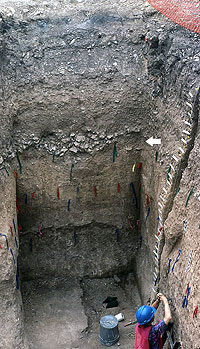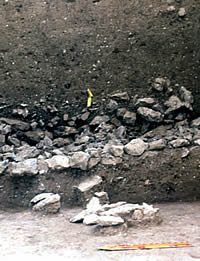Hot Rock Cooking Begins
Around 9,000 years ago (7,000 B.C.) at the outset of the Early Archaic period one of the region’s most distinctive archeological patterns first appears—evidence of the use of heated rocks to bake plant bulbs in layered cooking arrangements called earth ovens. Some of the most convincing evidence comes from the Wilson-Leonard site in the eastern Edwards Plateau near Leander. There, charred bulb fragments of Eastern Camas (Camassia scilloides—wild hyacinth) were found amid the remains of large hearth features six to eight feet across (2-2.5 m) representing the hot rock beds (heating elements) of several earth ovens. The charred bulbs were radiocarbon dated to 8000 and 8250 radiocarbon years BP. Camas bulbs are very small (about the same as a small green onion), but formerly grew thickly in the well-watered valleys of the eastern Plateau before being all but wiped out by historic domestic lifestock (such as cattle). Camas and other lily-family bulbs (like wild onions) are basically inedible when raw. Their complex carbohydrates must be broken down into readily digestible sugars, a process that requires slow-baking for 12-24 hours.
The earth oven technology shows that prehistoric peoples turned to a carbohydrate source that required special labor-intensive preparation. While we do not know whether the technique was developed first in the Plateaus and Canyonlands or adopted from elsewhere, the archeological evidence in the region ranks as among the earliest known in North America. We surmise that with more mouths to feed, people learned to take advantage of new food resources. Lily-family bulbs mature and become ready to harvest in the early spring when few other plant foods are available. They could be baked in bulk and then dried and stored. For archeologists this new cooking technology created what is perhaps the most visible and lasting of all archeological signatures in the region—large “hearths” and more massive accumulations of burned rock known as burned rock middens. Although we still lack clear proof that middens began forming during the Early Archaic, this was likely the case given the unmistakable evidence at Wilson-Leonard and several other sites. There, archeologists uncovered the “building blocks” by which middens accumulated—the hot rock beds resulting from earth ovens (so-called “large hearths”).
See Camp Bowie Middens and Honey Creek exhibits for more details.

